EFFECTS OF ELECTROSTIMULATION TRAINING ON MUSCLE STRENGTH AND POWER OF ELITE RUGBY PLAYERS
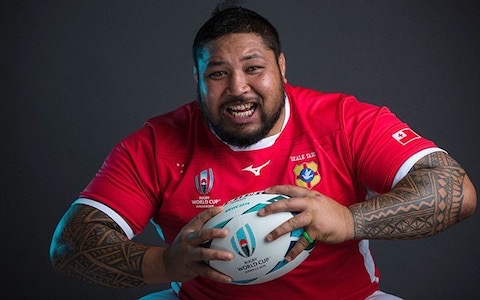
Journal of Strength and Conditioning Research, 2007, 21(2), 431–437
© 2007 National Strength & Conditioning Association
NICOLAS BABAULT,1 GILLES COMETTI,2 MICHEL BERNARDIN,3 MICHEL POUSSON,4 AND JEAN-CLAUDE CHATARD5
1Faculty of Sport Science, Marc Bloch University, Strasbourg, France; 2Performance Expertise Center, Faculty of
Sport Science, University of Burgundy, Dijon, France; 3French Rugby Federation, Paris, France; 4INSERM/ERM
207 Motricity-Plasticity, Faculty of Sport Science, University of Burgundy, Dijon, France; 5Laboratory of
Physiology, St-Etienne, France.
ABSTRACT. Babault, N., G. Cometti, M. Bernardin, M. Pousson, and J.-C. Chatard. Effects of electrostimulation training on muscle strength and power of elite rugby players. J. Strength Cond. Res. 21(2):431–437. 2007.—The present study investigated the influence of a 12-week electrostimulation (EMS) training program performed by elite rugby players. Twenty-five rugby players participated in the study, 15 in an electrostimulated group and the remaining 10 in a control group. EMS was conducted on the knee extensor, plantar flexor, and gluteus muscles. During the first 6 weeks, training sessions were carried out
3 times a week and during the last 6 weeks, once a week. Isokinetic torque of the knee extensors was determined at different eccentric and concentric angular velocities ranging from -120 to 360°·s-1. Scrummaging and full squat strength, vertical jump height and sprint-running times were also evaluated. After the first 6 weeks of EMS, only the squat strength was significantly improved (+8.3 ± 6.5%; p < 0.01). After the 12th week, the
-120°·s-1 maximal eccentric, 120 and 240°·s-1 maximal concentric torque (p < 0.05), squat strength (+15.0 ± 8.0%; p < 0.001), squat jump (+10.0 ± 9.5%; p < 0.01), and drop jump from a 40- cm height (+6.6 ± 6.1%; p < 0.05) were significantly improved. No significant change was observed for the control group. A 12- week EMS training program demonstrated beneficial effects on muscle strength and power in elite rugby players on particular tests. However, rugby skills such as scrummaging and sprinting were not enhanced.
KEY WORDS. isokinetic torque, scrum, sprint, vertical jump
INTRODUCTION
Rugby competition is typically characterized by high-intensity activities (15% of the game time) interspersed with low-intensity activities (11). On average, 70% of the high-intensity actions last from 4 to 10 seconds with the majority of rest periods being shorter than 40 seconds (26). Therefore, in addition to equally essential technical skills and aerobic endurance (required for low-intensity activities), rugby players must have sufficient anaerobic capacities to produce high levels of muscular strength, power, and speed (4, 8) required for heavy physical body contacts and sprints with or without the ball. As a matter of fact, professionals appear stronger and more powerful than younger players for both the upper and lower body (3). Consequently, before and during the rugby season, players participate in resistance training programs designed to improve and maintain their anaerobic parameters at high levels during the entire competition season (2).
Various training modalities can be used for improving muscular strength. More particularly, electromyostimulation (EMS) has been previously employed as a means of strength training in healthy humans (18, 31, 33). Many authors have reported increases in maximal voluntary torque during isometric actions for joint angles close to the training angle (20) and during isokinetic solicitations for a wide range of concentric and eccentric angular velocities (10, 20). Nevertheless, while monoarticular performance enhancements are well established, the EMS training effects during complex and specific polyarticular abilities remain unclear. Indeed, immediate significant improvements of the vertical jump height have been recorded (21, 38) but remain debated (9, 24). For example, Malatesta et al. (24) only registered vertical jump improvements 10 days after the end of the EMS training. Performance improvements, induced by EMS, may originate from neural factors (10, 13, 22) as well as changes in the muscle itself (15, 32) but seem to be closely related to training durations. Neural adaptations, revealed by both muscular activation and electromyographic activity increases, are mainly obtained after short EMS training periods (<4 weeks) (15, 22), whereas longer training durations (e.g., 8 weeks) are accompanied by significant muscular hypertrophy (15, 32).
Recently, some studies have examined
the training-induced adaptations following
short-term EMS programs on specific
athlete performance of various team sports (9, 20,
21). However, no study has attempted
to investigate EMS training effects in rugby players. Therefore,
the main purpose of the present investigation was to determine the influence of an EMS training program on muscle strength and power of elite rugby players.
Studies related with EMS predominantly considered short periods (<4 weeks).
Therefore, long-term effects were investigated here while performing
12 weeks of EMS training. Because highly skilled rugby
players were considered, this 12-week training duration seems more appropriate
for neuromuscular adaptations and for neuromuscular performance improvements during complex and specific abilities. The training program was divided into two 6-week intervals to simulate a taper period. We, therefore, hypothesized that 12 weeks of EMS training was beneficial for elite rugby players
and that reducing
training sessions during the last 6 weeks was associated with additional
physical performance improvements.
METHODS
Experimental Approach to the Problem
This study was designed to determine whether a long- term EMS training program (12 weeks) has beneficial effects in elite rugby players. Muscular adaptations were investigated by measuring the isokinetic torque during maximal voluntary eccentric and concentric knee extensions, scrummaging, and full squat strength, vertical jump performance, and sprint-running times. These variables were tested on 3 occasions: pretraining (week 0, beginning of the EMS training), mid-training (week 6), and posttraining (week 12). Two groups of elite rugby players were considered. During the 12-week period, the first group (control, C) only followed rugby trainings. The second group (electrostimulated, ES), in addition to the same rugby training, underwent a 12-week EMS training on the knee extensor, plantar flexor, and gluteus muscles. During the first 6 weeks, the EMS training program consisted of 3 sessions a week. Only 1 session per week was applied during the remaining 6 weeks to simulate a taper period (Figure 1). Statistical analyses of pretraining, midtraining, and posttraining values allowed us to evaluate the effect of 12-week EMS training on physical performances of elite rugby players. Independent variables were time (pretraining, midtraining, and posttraining) and group (ES and C). Values obtained for the different tests were used as dependent variables.
FIGURE 1. Illustration of the training procedure for both electrostimulated (ES) and control groups (C). During the experimental procedure, both groups performed rugby trainings with the same coach (5 sessions a week). In addition, the ES group underwent a 12-week electromyostimulation (EMS) training.
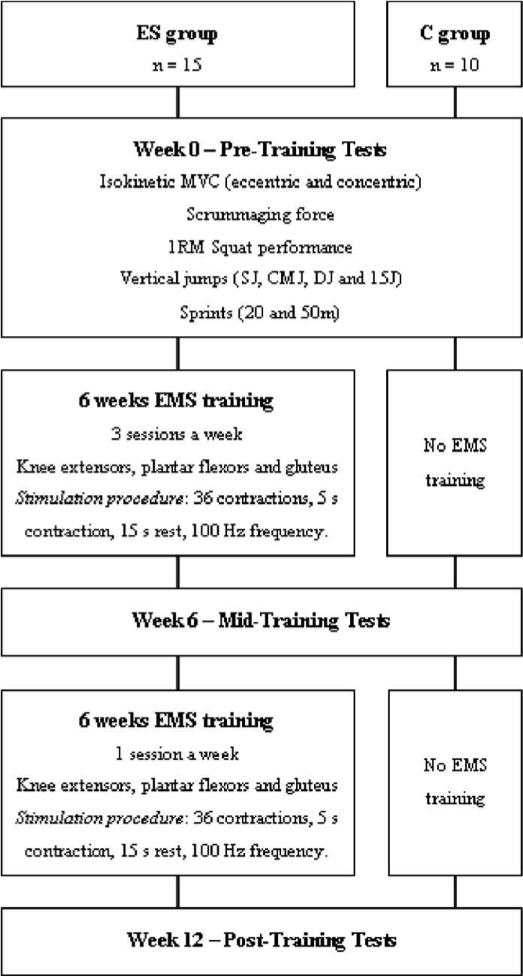
Tests at week 6 and 12 were the same as those performed before training. MVC = maximal voluntary contraction; 1RM=1 repetition maximum; SJ = squat jump; CMJ = counter movement jump; DJ = drop jump; 15J = 15 consecutive CMJ.
Subjects
A group of 25 highly skilled rugby players competing in the first or second division of the French Rugby league (with 3 players also competing in the national French team) participated in this study. All were members of the national French military team and were trained by the same coach. They were randomly divided into 2 groups. Fifteen subjects were assigned to the electrostimulation group (ES) and the remaining 10 served as controls (C). Mean age, height, and mass were 22 ± 1 year, 187.0 ± 8.5 cm, 93.2 ± 13.0 kg and 22 ± 1 year, 180.5 ± 3.2 cm, 85.9 ±10.6 kg, respectively, for ES and C groups. After being informed about the nature of the experiment, subjects agreed to take part in the study on a voluntary basis and provided their written informed consent for participation. The experimental procedure was performed in accordance with the declaration of Helsinki and was approved by the local committee of human research.
Procedures
Training. The present experiment started about 2 weeks after the end of the midwinter break. During this period, all athletes (i.e., ES and C group) took part in specific rugby workouts supervised by the national French military team coach (5 sessions a week including, e.g., defensive and attacking fundamentals). Special attention was given to reduce any training difference depending on player positions, and none of the subjects completed additional weight training. In addition to this rugby training, the ES group performed an EMS training program lasting 12 weeks. The EMS program was divided into 2 periods. The first 6 weeks consisted of 18 EMS sessions (12 minutes for each muscle group) with 3 sessions a week. During the remaining 6-week period, EMS training was composed of only 1 EMS session per week (Figure 1). EMS sessions were performed at the same time of the day and same days of the week.
EMS was delivered bilaterally on knee extensor, then plantar-flexor, and finally gluteus muscles using a portable battery-powered stimulator (Compex Medical SA, Ecublens, Switzerland). Rectangular-wave pulsed currents (100 Hz) lasting 400 µs were used as previously recommended (16, 36). Indeed, rectangular waves associated with long pulse durations (300 to 400 µs) appear to produce the most powerful contraction of the quadriceps muscle group (7); 100 Hz stimulation frequencies were used because 50 to 120 Hz frequencies have been shown to be the most efficient for strength training (16). During the 12-minute EMS sessions, contractions, lasting 5 seconds, were followed by 15 seconds of rest. During each session and for each muscle group, 36 contractions were completed. These stimulation characteristics were selected among the Compex commercially available strength programs. Because elite athletes were considered, the most difficult strength program was chosen and slightly modified (i.e., contraction number, rest time) to reduce EMS sessions durations. The stimulation intensity (range 0–100 mA) was monitored on-line and determined by the subject at the start of each EMS session according to his pain threshold and so as to produce a force corresponding to at least 60% of the pretest maximal voluntary contraction (MVC) score. This level was measured and verified by the examiner on the knee extensor muscles with a myostatic type dynamometer (Allegro, Sallanches, France). No subject reported serious discomfort from this current. Each session was preceded by a standardized warm-up, consisting of 5 minutes of submaximal EMS (5 Hz pulses; pulses lasting 200 µs).
The EMS was delivered using 2-mm thick self-adhesive electrodes. Pairs of positive electrodes (each measuring 25 cm2; 5 cm X 5 cm), which have the property of depolarizing the membrane, were placed as close as possible to the motor point of the vastus lateralis, vastus medialis, medial and lateral gastrocnemius, and gluteus maximus muscles. Rectangular negative electrodes, each measuring 50 cm2 (10 cm X 5 cm), were placed over the femoral triangle of each leg (1–3 cm below the inguinal ligament), over the proximal aspect of the gastrocnemii and gluteus, i.e., close to the proximal insertion of the respective muscle. During EMS of the knee extensor muscles, subjects were seated on a leg extension machine (Multiform, La Roque D’Anthe´ ron, France) with the knee flexed and fixed at a 60 ° joint angle (0° corresponding to complete knee extension). For plantar flexor muscles EMS, subjects were seated on a calf machine (Multiform) with joint angles at the hip, knee and ankle maintained at ~90°. The subjects lay in the prone position during EMS of the gluteus muscles.
Testing
Tests were carried out in both groups before (week 0), in the middle (week 6), and immediately after the end of the training period (week 12) (Figure 1). Tests, conducted in a single session, consisted in the evaluation of (a) muscular strength by measuring the maximal voluntary isokinetic eccentric and concentric torque production capacity, scrimmaging, and squat strength and (b) power with the determination of vertical jump heights and power and sprint-running times.
Isokinetic Tests. The maximal voluntary torque of the right knee extensor muscles was measured using a Biodex isokinetic dynamometer (Biodex, Shirley, NY) validated by Taylor et al. (35). Subjects were seated upright on the dynamometer chair with a 95° hip angle. Velcro straps were applied tightly across the thorax and pelvis; the leg being fixed to the dynamometer lever-arm. The axis of rotation of the dynamometer was aligned to the lateral femoral condyle, indicating the anatomical joint axis of the knee. Arms were positioned across the chest with each hand clasping the opposite shoulder. After a standardized warm-up session including submaximal concentric and eccentric knee extensions with progressively increasing intensity until the MVC, subjects performed maximal voluntary leg extensions at 8 different angular velocities. Two eccentric (-60 and -120°·s-1) and 6 concentric (60, 120, 180, 240, 300 and 360°·s-1) angular velocities were considered. Three consecutive contractions were achieved for each angular velocity and only the best peak voluntary torque was retained for analysis. Angular velocities were randomly presented and a 4-minute rest period was allowed between each velocity to avoid fatigue effects. Leg extensions were conducted within a 90° range of motion (from 90 to 0°; 0° corresponding to the complete knee extension). Appropriate corrections were made for the gravitational effect of the leg for all torque measurements. Whatever the contraction, subjects were strongly encouraged by the same investigator to push as hard as possible to perform all actions maximally, i.e., throughout the whole range of motion for concentric and eccentric contractions.
Scrum Test. Specific rugby strength was measured using a scrum machine (Multiform). The isometric scrum maging force was assessed by means of strain gauge force transducers (Captels, St. Mathieu de Tre´ viers, France). The scrum machine was fixed in a horizontal position with height adjusted according to each subject’s position. Subjects were free to choose their scrummaging position. Knee flexion angles and feet positions were determined individually and fixed using wedges. Positions were recorded so as to be identical for all test sessions. Each player was allowed to perform three 5-second trials, in which he attempted to push as hard as possible against the 2 central pads of the machine. Four-minute rest periods were allowed between trials. Force, measured at stabilization after impact, was evaluated for all trials and only the best performance was retained for analysis.
Squat Test. Subjects were evaluated during concentric strength tests while performing full squats (starting position = complete knee flexion). Players were tested for 1 repetition maximum (1RM) using standard Olympic style bar and weights. Players were familiar with squats since all have previously performed such movements during their training program. Each subject performed submaximal repetitions at low weights for warm-up before gradually increasing the load (10-kg increments, then 5-kg increments near maximum) until the maximum. Fourminute rest periods were allowed between trials. Vertical Jump Tests. Jumping ability was evaluated with a contact mat (Ergo tests, Globus, Codogne, Italy) measuring the flight time of the jumps. Squat jumps (SJ), counter movement jumps (CMJ), drop jumps (DJ), and 15 repetitive CMJ (15J) were randomly performed. For each test, subjects were asked to jump as high as possible with their hands kept on the hips to minimize the contribution of the upper body. The SJ started from a static semisquatting position (~90° knee flexion), maintained ~1 second; subjects were instructed to jump without any preliminary movement. The CMJ started from a standing position. Subjects were instructed to squat down until a 90° knee flexion angle and to extend the knee in 1 continuous movement. The DJ started from a standing position at a 40-cm height above the floor. Subjects then dropped on the contact mat, squatted down until 90° knee flexion and extended the knee in 1 continuous movement. Three trials were performed for SJ, CMJ, and DJ, with a 2-minute rest period between trials, and the best performance was recorded. For 15J, 15 consecutive CMJ were performed without any rest between jumps. Only 1 trial was achieved for this jump test. The average height and power were then calculated according to single jump flight and contact time.
Sprint Test. Because, high-intensity rugby actions are shorter than 10 seconds (21), running times were evaluated during 20- and 50-m maximal running tracks using infrared photoelectric cells (TT Sport, Dogana, San Marino). Cells, positioned at a 1.15-m height, were placed 20 and 50 m from the start line. Subjects started in a standing position and ran the 50-m distance as fast as possible. During this maximal run, both the 20- and 50-m times were measured. These performances did not include the reaction time. Three trials were performed with a 4-minute rest period, and the best performance was retained for subsequent statistical analysis.
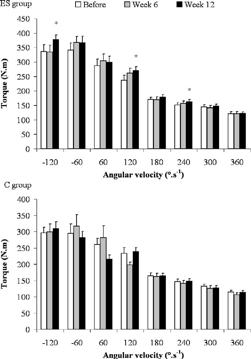
FIGURE 2. Torque-angular velocity relationships of the knee extensors for electrostimulated (ES, upper graph) and control groups (C, lower graph) before and after a 6-week and 12-week period. Values are mean (± SE). * Differences between values obtained before and after the 12-week training period (p < 0.05).
Statistical Analyses
Mean values ± SD were calculated for all dependent variables (i.e., knee extension torque, scrum and squat strength, vertical jump height or power, and running times). Figures are presented as mean value ± SE for more clarity. Values were analyzed using a 2-way analysis of variance to test differences between groups (ES or C) and time (before, after week 6, or after week 12). Time factor was analyzed as repeated measures. F ratio was considered significant at a p level less than 0.05. A Newman-Keuls post hoc test was conducted if significant main effects or interactions were present. Statistical analyses were undertaken using Statistica software for Windows (StatSoft, Version 5, Tulsa, OK).
RESULTS
At midtraining, the ES group did not exhibit any modification of the torque-angular velocity relationship (Figure 2). After 12 weeks of training, the ES group exhibited significant voluntary torque improvements (p < 0.05) under eccentric (+18.0 ± 26.3% at -120°·s-1) and concentric conditions (+19.4 ± 28.9% at 120°·s-1 and +10.0 ± 21.5% at 240°·s-1) compared with pretraining. In the same way, the squat strength enhancement was +8.3 ± 6.5% and +15.0 ± 8.0%, respectively after a 6- (p < 0.01) and 12- week (p < 0.01) EMS training period (Figure 3). A significant squat improvement was also recorded between mid- and posttraining (+6.2 ± 4.9%; p < 0.05). The scrummaging strength did not demonstrate any time effect (Figure 4).
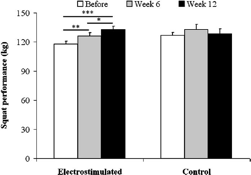
FIGURE 3. Squat performance (kg) for electrostimulated and control groups before and after a 6-week and 12-week period. Values are mean (± SE). Differences between before, week 6, and week 12 are shown (* p < 0.05, ** p < 0.01, and *** p < 0.001).
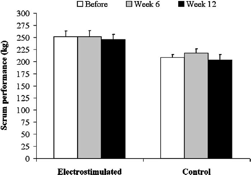
FIGURE 4. Scrummaging performance (kg) for electrostimulated and control groups before and after a 6-week and 12- week period. Values are mean (± SE). The electrostimulated (ES) group showed significantly higher values than the control (C) group. Whatever the group, no difference was obtained with time (before vs. week 6 vs. week 12).
A significant improvement in vertical
jump height (p < 0.05) was obtained after 12 weeks of EMS training for SJ and DJ (Table
1). For these 2 tests (SJ and DJ), no difference was recorded when comparing values registered before and after 6 weeks of EMS training.
After the 12th week, the performance enhancement was +10.0 ± 9.5% (p < 0.01) and +11.8 ± 9.9% (p < 0.001) for SJ and +6.6 ± 6.1% (p < 0.05) and +7.6 ± 5.7% (p < 0.05) for DJ when respectively compared
with pre- and midtraining
tests. No difference was obtained with time for ES when considering
the 2 other jump tests (i.e., CMJ and 15J) and running
times (Table 2). At baseline, the ES group exhibited
significantly higher scrummaging values and lower vertical jump and sprint
performances than the C group. No difference was obtained for the
torque-angular velocity relationship and squat strength.
After the 6-week and 12-week periods, the C group did not
demonstrate any significant changes for all tests.
TABLE 1. Vertical jump performances (mean value ± SD) on electrostimulated (ES) and control (C) groups before and after a
6-week and 12-week training period.*

* SJ = squat jump; CMJ = counter movement jump; DJ = drop jump; 15J = 15 repetitive CMJ. Differences between before and week 12 training are shown († p < 0.05 and ‡ p < 0.01). Differences between week 6 and 12 are also shown (§ p < 0.05 and / p < 0.001). Except for 15J power and SJ after week 12, group C exhibited significantly higher values than group ES.
TABLE 2. Running times for electrostimulated (ES) and con- trol (C) groups over 20 and 50 m before and after a 6-week and

* Group C exhibited significantly lower values than ES. What- ever the group, no difference was obtained with time (before vs. week 6 vs. week 12).
DISCUSSION
EMS is largely employed for strength training but no study has established its effect in rugby players. The present study demonstrated that a 12-week EMS training program has positive effects on muscle strength and power of highly skilled rugby players. Moreover, reduction of the training session number from 3 to once a week during the last 6 weeks, like in a taper period, was beneficial for physical performance improvements.
After a 12-week training period, EMS produced improvements in (a) muscle strength as revealed by maximal voluntary torque and squat strength measurements and (b) power (i.e., SJ and DJ height). Although performed isometrically, gains were primarily registered during dynamic and more particularly concentric actions. Moreover, the stimulation of the main extensor muscles of the lower limb yield to improvements in both single-joint and multi-joint performances.
Posttraining, rugby players exhibited increases in squat strength and maximal voluntary torque during isokinetic tests performed under eccentric (-120°·s-1) and concentric conditions (120 and 240°·s-1). Magnitudes of the relative strength increases (on average +16%) were consistent with previous EMS studies (9, 20, 29) but appeared larger than reported by others (10, 25). Gains were obtained after the 12th week, whereas the previous experiments consisted in shorter training programs (e.g., 3 weeks for ref. 29). For example, after a 4-week EMS training period, Maffiuletti et al. (20) registered a 29% torque increase under eccentric condition at -120°·s-1. Using slightly longer training duration (7 weeks) Colson et al. (10) registered only ~10% torque increases at a -120°·s-1 eccentric angular velocity. Differences between the present experiment and these studies could be partly attributed to differing stimulation modes (e.g., stimulation frequencies), muscle group (knee extensors vs. elbow flexors), and training status of the subjects considered. Indeed, in the present study, subjects were all highly skilled rugby players. It is generally accepted that strength gains, consecutive to training, are usually lower for highly skilled than for sedentary subjects (1). Therefore, long-term EMS seems to be more appropriate for elite rugby players to improve muscle strength.
Paradoxically, the present study showed performance improvements for squat strength and not for scrummaging. High muscle strength of the whole lower body (trained here with EMS) is needed to obtain elevated performances for these 2 tests. The lack of gain in the scrum test could be partly explained by factors such as technique or motivation. Quarrie and Wilson (30) demonstrated that the scrum force was primarily related to anthropometric characteristics and physical factors such as anaerobic power attained on a cycle ergometer and to a lesser extent to isokinetic knee extension torque. Therefore, it may be postulated that isokinetic torque increases, observed in the present study, were not sufficient to induce enhancements of scrummaging performance. Furthermore, both forward and back players participated in this experiment. Backs, uninvolved and unfamiliar with scrummaging, were technically less skilled for strength transfer for this type of exercise. Quarrie and Wilson (30) noted that technique and coordination may be the most important parameters for maximal scrum force. Therefore, association of technique and EMS training might lead to performance improvements and might also minimize the risk of potential injury during the rugby union scrum (27).
Muscular strength, enhanced with EMS, is an essential anaerobic characteristic for rugby players. Power, as well as important for rugby players, was also improved as revealed by SJ and DJ height increases. However, both repetitive jumps (15J) and running times remained unchanged after the 12-week training period. The lack of change, in disagreement with previous investigations (9, 24), was unexpected since EMS was performed on the main lower limb extensor muscles. According to Wisloff et al. (37), gains of maximal quadriceps femoris isokinetic torque and squat strength should have been associated with decreased sprint times. However, Wisloff et al. (37) suggested emphasizing concentric movements during strength training for a better sprint improvement. Herrero et al. (17) also concluded that EMS training alone did not result in any improvement in jumping height or even interfered in sprint run. Likewise, as suggested by Bobbert and Van Soest (5), strength-training programs should be associated with specific exercises to improve jumping ability by an optimization of the control of neuromuscular properties. Therefore, EMS training, conducted under isometric conditions, should be accompanied with specific dynamic exercises (e.g., jumping and sprinting) for a better power improvement.
Like in a taper period, EMS training consisted of 3 sessions a week during the first 6 weeks and only 1 session from the sixth to the 12th week. Midtraining, our results revealed only squat strength increases (+8.3%). Despite the reduction in the number of EMS sessions, a squat strength improvement was also obtained between the sixth and 12th week (+6.2%). Besides, most increases in muscle strength and power were obtained during the second part of the training program. Indeed, voluntary isokinetic torque and vertical jump height predominantly increased after week 6. These results demonstrated that reducing EMS volume (sessions per week) was beneficial for physical performance enhancements. Quite similarly, the reduction of heavy-resistance training session number previously exhibited strength increases but for elderly subjects (19). With EMS, no study demonstrated the positive effects of training volume reduction. Nevertheless, stopping EMS trainings produced persisting results (25) or delayed positive effects (20, 24). Indeed, Malatesta et al. (24) obtained SJ and CMJ increases 10 days after the end of EMS training while no gain was obtained immediately after the 4 weeks of training.
Except for squat strength, the absence of performance improvements at midtraining was surprising. Indeed, studies dealing with EMS generally registered voluntary torque (9, 20, 29) and vertical jump height (21, 24) gains for short training durations (<4 weeks). As stated above, this result could partly be explained by the elite training status of our subjects. Moreover, the lack of significant vertical jump gain at week 6 could be attributed to the fact that subjects tested in the present study were not specifically trained for vertical jumps. Combination of EMS with specific exercises such as scrummaging or vertical jumps might favor physical performance improvements. Indeed, no gain was observed midtraining for vertical jumps, whereas Maffiuletti et al. (21) registered ~7 cm increases for SJ after only 4 weeks EMS combined with plyometric exercises. More recently, Brocherie et al. (9) suggested that EMS training programs should be of longer duration when performed alone to achieve beneficial effects in vertical jump height. Present results support this hypothesis since vertical jump improvements (~3 cm for SJ) were obtained with training duration 4 times longer than the last cited study (12 vs. 3 weeks). Therefore, it can be concluded that long-term EMS programs (>6 weeks) conducted alone or short-term programs accompanied by jump exercises are required to obtain significant improvements in vertical jump height.
Mechanisms, related with muscle strength and power increases after EMS training, may originate from central neural drive adaptations (13, 22) and/or from peripheral modifications, i.e., hypertrophy (12). Most authors favor the neural drive hypothesis because EMS training is generally not long enough (<5 weeks) to induce modifications at the muscle level (15). The observed increased EMG activity (10) and higher activation level (22) corroborate this enhanced volitional drive originating from spinal as well as supraspinal centers. However, the absence of reflex modification after 4 weeks of EMS training suggests that neural adaptations were primarily supraspinal (23). This suggestion is reinforced by Smith et al. (34). Despite the fairly long training period used in the present study (12 weeks), we think that performance improvements more likely resulted from neural processes than peripheral muscular adaptations. Peripheral adaptations would effectively produce uniform torque gains among velocities while gains were obtained for only 3 angular velocities and in particular under eccentric conditions (-120°·s-1). Part of this increase in eccentric torque may originate from preferential adaptations of fast twitch fibers (22). Indeed, EMS (14) and eccentric actions (28) have been shown to preferentially recruit fast twitch fibers. Although peripheral adaptations cannot be excluded, the increased neural drive or preferential activation of fast muscle fibers, may additionally explain the improvement in explosive-type actions (e.g., vertical jumps) (6) by an optimization of neuromuscular properties control during complex dynamic tasks (24).
PRACTICAL APPLICATIONS
Muscle strength and power appear to be important parameters for rugby players’ careers. On the basis of the present investigation, it appears that EMS can be used on rugby players, even with highly skilled athletes, for strength and jumping ability improvements. However, specific rugby skills such as scrummaging and sprint-running were not improved with EMS. In the practical setting, it is suggested to combine technical and more specific rugby exercises with EMS so as to optimize strength gains. Furthermore, reducing EMS sessions during the second half of our training program (from week 6 to week 12) demonstrated persistent physical performance enhancements. This result is of interest for the rugby players’ conditioning periodization. Indeed, EMS could be conducted during the preseason conditioning and prolonged during the in-season conditioning with a lower volume. The in-season EMS volume reduction could, therefore, be helpful for performance maintenance across the whole season (essential for successful rugby competition). EMS training volume should, therefore, be carefully periodized and sequenced with complementary exercises for optimal gains and performance preservation in elite rugby players.
REFERENCES
1. AHTIAINEN, J.P., A. PAKARINEN, M. ALEN, W.J. KRAEMER, AND K. HA¨ KKI- NEN. Muscle hypertrophy, hormonal adaptations and strength training in strength-trained and untrained men. Eur. J. Appl. Physiol. 89:555–
563. 2003.
2. BAKER, D. The effects of an in-season of concurrent training on the maintenance of maximal strength and power in professional and college-aged rugby league football players. J. Strength Cond. Res. 15:172–177. 2001.
3. BAKER, D. Differences in strength and power among junior-high, senior- high, college-aged, and elite professional rugby league players. J. Strength Cond. Res. 16:581–585. 2002.
4. BAKER, D., AND S. NANCE. The relation between running speed and measures of strength and power in professional rugby league players. J. Strength Cond. Res. 13:230–235. 1999.
5. BOBBERT, M.F., AND A.J. VAN SOEST. Effects of muscle strengthening on vertical jump height: A simulation study. Med. Sci. Sports Exerc. 26:
1012–1020. 1994.
6. BOSCO, C., AND P.V. KOMI. Mechanical characteristics and fiber composition of human leg extensor muscles. Eur. J. Appl. Physiol. 41:275–284.
1979.
7. BOWMAN, B.R., AND L.L. BAKER. Effects of waveform parameters on com- fort during transcutaneous neuromuscular electrical stimulation. Ann. Biomed. Eng. 13:59–74. 1985.
8. BREWER, J., AND J. DAVIS. Applied physiology of rugby league. Sports
Med. 20:129–135. 1995.
9. BROCHERIE, F., N. BABAULT, G. COMETTI, N. MAFFIULETTI, AND J.C. CHA- TARD. Electrostimulation training effects on the physical performance of ice hockey players. Med. Sci. Sports Exerc. 37:455–460. 2005.
10. COLSON, S., A. MARTIN, AND J. VAN HOECKE. Re-examination of training effects by electrostimulation in the human elbow musculoskeletal system. Int. J. Sports Med. 21:281–288. 2000.
11. DEUTSCH, M.U., G.J. MAW, D. JENKINS, AND P. REABURN. Heart rate, blood lactate and kinematic data of elite colts (under-19) rugby union players during competition. J. Sports Sci. 16:561–570. 1998.
12. DUCHATEAU, J., AND K. HAINAUT. Training effects of sub-maximal electrostimulation in a human muscle. Med. Sci. Sports Exerc. 20:99–104. 1988.
13. ENOKA, R.M. Muscle strength and its development. New perspectives. Sports Med. 6:146–168. 1988.
14. FEIEREISEN, P., J. DUCHATEAU, AND K. HAINAUT. Motor unit recruitment order during voluntary and electrically induced contractions in the tibialis anterior. Exp. Brain Res. 114:117–123. 1997.
15. GONDIN, J., M. GUETTE, Y. BALLAY, AND A. MARTIN. Electromyostimulation training effects on neural drive and muscle architecture. Med. Sci Sports Exerc. 37:1291–1299. 2005.
16. HAINAUT, K., AND J. DUCHATEAU. Neuromuscular electrical stimulation and voluntary exercise. Sports Med. 14:100–113. 1992.
17. HERRERO, J.A., M. IZQUIERDO, N.A. MAFFIULETTI, AND J. GARCIA-LOPEZ. Electromyostimulation and plyometric training effects on jumping and sprint time. Int. J. Sports Med. 27:533–539. 2006.
18. HORTOBAGYI, T., K. SCOTT, J. LAMBERT, G. HAMILTON, AND J. TRACY. Cross-education of muscle strength is greater with stimulated than voluntary contractions. Motor Control 3:205–219. 1999.
19. LEXELL, J., D.Y. DOWNHAM, Y. LARSSON, E. BRUHN, AND B. MORSING. Heavy-resistance training in older Scandinavian men and women: Short- and long-term effects on arm and leg muscles. Scand. J. Med. Sci. Sports 6:329–341. 1995.
20. MAFFIULETTI, N.A., G. COMETTI, I.G. AMIRIDIS, A. MARTIN, M. POUSSON, AND J. VAN HOECKE. The effects of electromyostimulation training and basketball practice on muscle strength and jumping ability. Int. J. Sports Med. 21:437–443. 2000.
21. MAFFIULETTI, N.A., S. DUGNANI, M. FOLZ, E. DI PIERNO, AND F. MAURO. Effect of combined electrostimulation and plyometric training on vertical jump height. Med. Sci. Sports Exerc. 34:1638–1644. 2002.
22. MAFFIULETTI, N.A., M. PENSINI, AND A. MARTIN. Activation of human plantar flexor muscles increases after electromyostimulation training. J. Appl. Physiol. 92:1383–1392. 2002.
23. MAFFIULETTI, N.A., M. PENSINI, G. SCAGLIONI, A. FERRI, Y. BALLAY, AND A. MARTIN. Effect of electromyostimulation training on soleus and gastrocnemii H- and T-reflex properties. Eur. J. Appl. Physiol. 90:601–607. 2003.
24. MALATESTA, D., F. CATTANEO, S. DUGNANI, AND N.A. MAFFIULETTI. Effects of electromyostimulation training and volleyball practice on jumping ability. J. Strength Cond. Res. 17:573–579. 2003.
25. MARQUESTE, T., F. HUG, P. DECHERCHI, AND Y. JAMMES. Changes in neuromuscular function after training by functional electrical stimulation. Muscle Nerve 28:181–188. 2003.
26. MENCHINELLI, C., C. MORANDINI, AND M. DE ANGELIS. A functional model of rugby: Determination of the characteristics of sports performance [Abstract]. J. Sports Sci. 10:196–197. 1992.
27. MILBURN, P.D. Biomechanics of rugby union scrummaging. Technical and safety issues. Sports Med. 16:168–179. 1993.
28. NARDONE, A., AND M. SCHIEPPATI. Shift of activity from slow to fast muscle during voluntary lengthening contraction of the triceps surae muscle in humans. J. Physiol. 395:363–381. 1988.
29. PICHON, F., J.C. CHATARD, A. MARTIN, AND G. COMETTI. Electrical stimulation and swimming performance. Med. Sci. Sports Exerc. 27:1671–1679. 1995.
30. QUARRIE, K.L., AND B.D. WILSON. Force production in the rugby union scrum. J. Sports Sci. 18:237–246. 2000.
31. ROMERO, J.A., T.L. SANFORD, R.V. SCHROEDER, AND T.D. FAHEY. The effects of electrical stimulation of normal quadriceps on strength and girth. Med. Sci. Sports Exerc. 14:194–197. 1982.
32. RUTHER, C.L., C.L. GOLDEN, R.T. HARRIS, AND G.A. DUDLEY. Hypertrophy, resistance training, and the nature of skeletal muscle activation. J. Strength Cond. Res. 9:155–159. 1995.
33. SELKOWITZ, D.M. Improvement in isometric strength of the quadriceps femoris muscle after training with electrical stimulation. Phys. Ther. 65:186–196. 1985.
34. SMITH, G.V., G. ALON, S.R. ROYS, AND R.P. GULLAPALLI. Functional MRI determination of a dose-response relationship to lower extremity neuromuscular electrical stimulation. Exp. Brain Res. 150:33–39. 2003.
35. TAYLOR, N.A., R.H. SANDERS, E.I. HOWICK, AND S.N. STANLEY. Static and dynamic assessment of the Biodex dynamometer. Eur. J. Appl. Physiol. 62:180–188. 1991.
36. VANDERTHOMMEN, M., AND J.M. CRIELAARD. Muscle electric stimulation in sports medicine. Rev. Med. Liege 56:391–395. 2001.
37. WISLOFF, U., C. CASTAGNA, J. HELGERUD, R. JONES, AND J. HOFF. Strong correlation of maximal squat strength with sprint performance and vertical jump height in elite soccer players. Br. J. Sports Med. 38:285–288. 2004.
38. WOLF, S.L., G.B. ARIEL, D. SAAR, M.A. PENNY, and P. RAILEY. The effect of muscle stimulation during resistive training on performance parameters. Am. J. Sports Med. 14:18–23. 1986.
Acknowledgments
The authors gratefully acknowledge Dr. Nicola A. Maffiuletti and Dr. Gerald G. Pope for carefully reviewing the manuscript and English corrections. Address correspondence to Nicolas Babault, nicolas. babault@u-bourgogne.fr.

